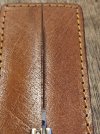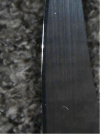. I have had this issue on several RR knives
I've been "lucky". Haven't had had to put up with RAP* on any of my 60+ RR's.
I wonder if RAP is pattern dependemt?
I've not experienced it on a Barlow, Canoe, Teardrop, Stockman, "Sodbuster" (type), 2 slipjoint folding hunter, .or other pattern I have from different mnufacturers.
*IMHO "Blade Rap" sucks. However, it is preferable to "RAP Music".
RAP "Music" gives me a headache. If I want to be cursed at, called nasty names, blamed for and accused of things I ain't never done did in my "life" (and have less than zero desire to do), and otherwise be disrespected, I can just call my ex wife, thank you very much.

I just cannot relate to that "music".
(or "Country Western" "music". All that "singing" through their nose, along with the fake "southern" accent and/or "Texas" drawl ... gives me a headache AND a earache.

Rock n Roll can roll on down the mountain (or off a mile high cliff) s'far as I'm concerned, too.)





